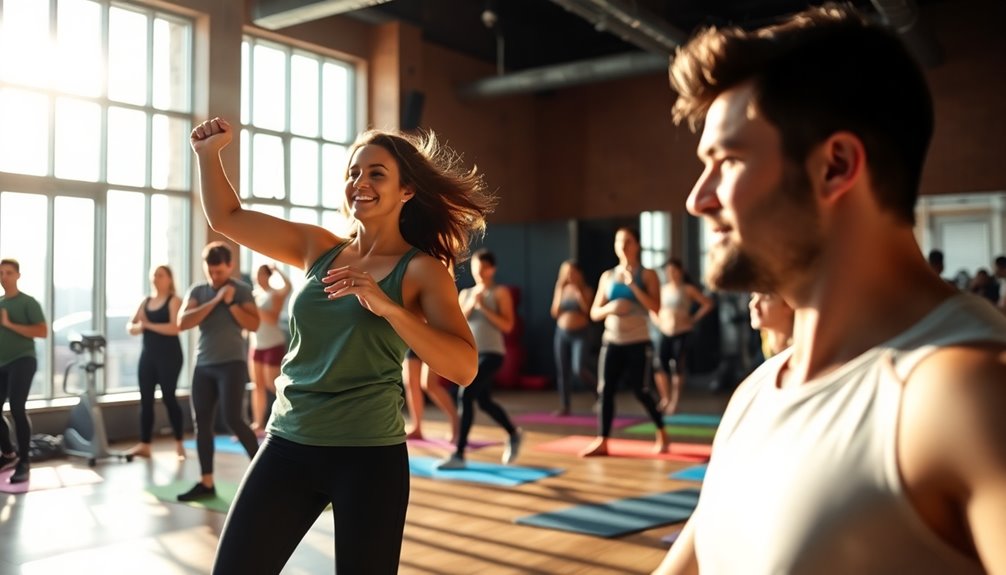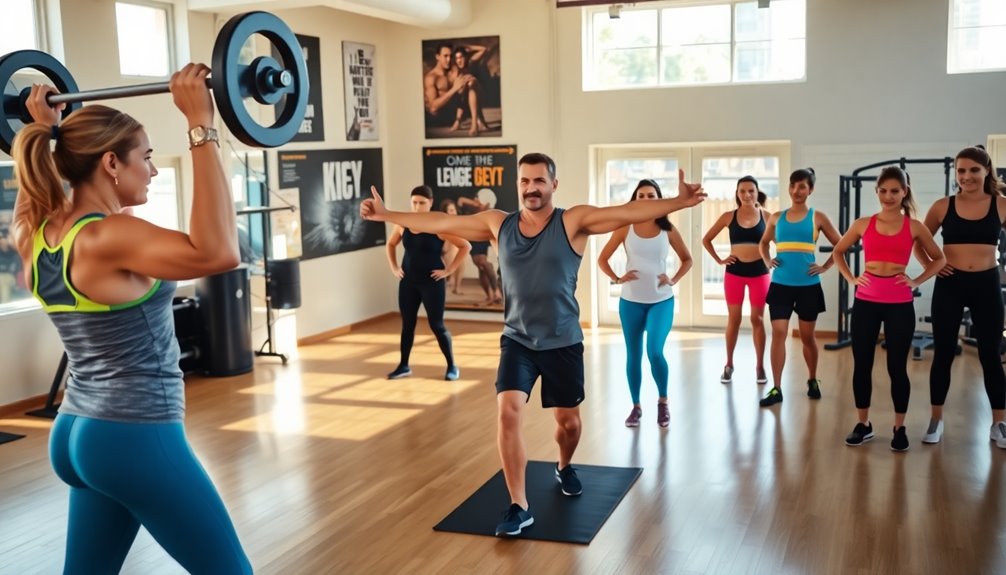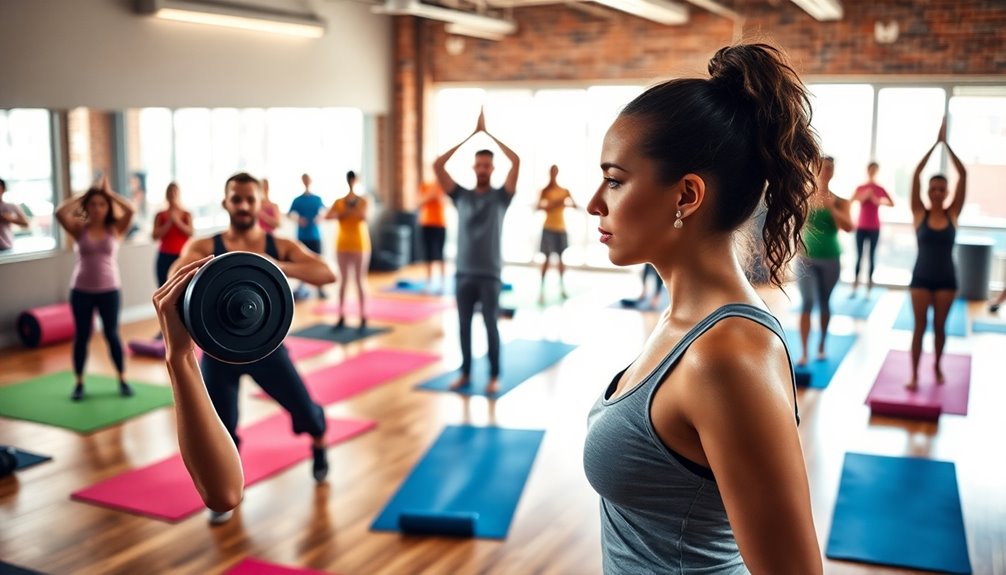To find the right fitness program for your goals, start by defining clear and achievable objectives using SMART criteria. Assess your current fitness level and choose activities you enjoy, like cycling or weightlifting, to stay committed. Explore various programs, from full-body workouts for beginners to more specialized routines for advanced lifters. Consider professional guidance to tailor your routine and reduce injury risk. Don't forget to evaluate your schedule for flexibility and set realistic expectations for progress. With the right approach, you'll reveal your full potential as you discover what works best for you. There's much more to uncover!
Key Takeaways
- Assess your current fitness level using metrics like waist circumference and push-up count to set realistic goals.
- Choose a fitness program that aligns with your personal preferences, whether that's group classes or solo workouts.
- Explore a variety of workout routines, such as full body, push/pull/legs, or body part splits, tailored to your specific objectives.
- Consider trial classes to evaluate instructor quality and class environment before committing to a program.
- Schedule workouts consistently, aiming for 150 minutes of moderate aerobic activity weekly, and gradually increase intensity.
Define Your Fitness Goals
Defining your fitness goals is essential for staying focused and motivated on your journey. To make them effective, use the SMART criteria—specific, measurable, achievable, relevant, and time-bound. For instance, a short-term goal like losing 5 pounds within a month can serve as a stepping stone to a long-term objective, such as running a marathon or reaching a desired body composition.
Start by evaluating your current fitness level through metrics, such as waist circumference or your push-up count. This gives you a clear baseline to establish realistic and achievable goals. For example, if you find that you can only do 10 push-ups now, aiming for 15 in a month is reasonable and motivating.
It's also vital to set a timeline for your goals. Consider goals like a 10% increase in workout intensity each month to maintain accountability and encourage steady progress.
Consider Personal Preferences

Staying committed to your fitness journey often hinges on personal preferences. When you choose fitness programs that you genuinely enjoy, you're much more likely to stick with your training.
Think about whether you thrive in group classes or prefer the solitude of solo workouts. Many people find that social interaction boosts their motivation, making group sessions more enjoyable.
Evaluate the activities that bring you satisfaction, whether it's cycling, swimming, or weightlifting. Selecting a program that aligns with your interests can make a significant difference in your commitment.
Also, consider your workout environment. Do you feel energized outdoors or do you prefer the controlled setting of a gym? The right environment can enhance your experience.
Lastly, think about how a fitness program fits into your lifestyle. A routine that offers schedule flexibility and is easily accessible will be more sustainable in the long run.
Assess Your Current Fitness Level

To kick off your fitness journey, it's essential to measure your physical abilities.
By identifying your strengths and weaknesses, you can set baseline fitness metrics that guide your progress.
This assessment will help you create a tailored program that meets your specific needs.
Measure Your Physical Abilities
Evaluating your current fitness level is essential for tailoring a program that meets your individual needs and goals. Start by measuring your cardiovascular endurance. Record your pulse rate before and after walking 1 mile (1.6 km) and time yourself to complete this distance or run 1.5 miles (2.41 km). This gives you a baseline for aerobic fitness.
Next, assess your muscular fitness by counting how many standard or modified push-ups you can complete in one go. This helps gauge your upper body strength effectively.
Don't forget to check your flexibility and mobility by evaluating your range of motion in key joints, including hips, knees, ankles, shoulders, and elbows.
To understand your body composition better, calculate your waist circumference and body mass index (BMI). These measurements provide insights into your overall health status and can help you measure your progress over time.
Identify Strengths and Weaknesses
Knowing your current fitness level sets the stage for identifying your strengths and weaknesses. Start by recording your pulse rate before and after walking 1 mile to assess your cardiovascular endurance. This will give you a clear picture of your heart health and stamina.
Next, measure the time it takes to walk 1 mile or run 1.5 miles; this serves as a benchmark for your aerobic fitness.
To evaluate upper body strength, count how many standard or modified push-ups you can perform in one set. This exercise highlights your muscular endurance and strength.
Don't forget to assess your flexibility by checking the range of motion in your joints, such as hips, knees, and shoulders. Identifying any mobility limitations can help you tailor your fitness routine.
Additionally, calculate your waist circumference and body mass index (BMI) to gain insights into your body composition and overall health.
Set Baseline Fitness Metrics
Regularly reviewing your current fitness level is essential for setting effective baseline metrics. Start by evaluating your cardiovascular endurance; record your pulse rate before and after a one-mile walk. This gives you insight into your heart health and stamina.
Next, time yourself walking one mile or running 1.5 miles to establish your aerobic capacity, which is vital for any fitness program focused on weight loss.
To assess upper body strength, count how many standard or modified push-ups you can do in one set. This helps you understand your strength in the major muscle groups.
Don't forget to check your flexibility by examining the range of motion in major joints like your hips, knees, and shoulders.
Lastly, calculate your waist circumference and body mass index (BMI). These metrics are significant indicators of your overall health and fitness status.
Explore Different Fitness Programs

When it comes to fitness programs, you've got plenty of options to choose from.
Each program can be tailored to meet your specific goals, whether you want to build strength, improve endurance, or focus on overall fitness.
Exploring these different approaches will help you find the best fit for your lifestyle and aspirations.
Program Variety and Options
With a range of fitness programs available, you can easily find one that suits your goals and experience level. Each program offers unique benefits and caters to different needs in strength training. Here's a summary of some effective training programs:
| Program Type | Ideal For | Frequency |
|---|---|---|
| Full Body Workouts | Beginners | 3 sessions/week |
| Upper/Lower Splits | Strength development seekers | 4 sessions/week |
| Push/Pull/Legs | Consistent trainers | 3+ sessions/week |
| Body Part Splits | Experienced lifters | 5 sessions/week |
Full body workouts are perfect for beginners looking to improve strength and lose fat with just three sessions a week. If you're focused on strength, upper/lower splits can increase training volume within four days. For those who can commit to three sessions, push/pull/legs routines allow for efficient muscle recovery while maintaining frequency. Finally, body part splits are designed for experienced lifters who prefer to isolate muscle groups and can dedicate five days a week to training. Explore these options to discover the right fit for you!
Tailored Approaches for Goals
To achieve your fitness goals effectively, it's essential to choose a program tailored to your needs and preferences. If building muscle is your objective, consider a push/pull/legs program. This approach focuses on compound exercises, allowing you to train different muscle groups while providing ample recovery time.
It's perfect if you can commit to at least three workouts a week.
For beginners or those with limited time, full body workouts are a great choice. They target all major muscle groups multiple times a week, promoting overall strength.
On the other hand, if you're more experienced and prefer isolation exercises, a body part split might suit you better. Just be prepared to dedicate five days a week to your routine.
Consulting a fitness coach can also help tailor a program that aligns with your specific goals, whether that's improving athleticism or achieving leanness.
Remember, incorporating cardio training alongside your strength regimen will enhance cardiovascular endurance, which is essential for peak fitness results.
Ultimately, aligning your fitness program with your schedule and preferences will boost your adherence and success on your fitness journey.
Seek Guidance From Professionals

Seeking guidance from professionals can greatly elevate your fitness journey. By consulting certified trainers or fitness coaches, you get personalized assessments that clarify your fitness goals and current capabilities. This tailored approach guarantees your exercise regimen accommodates any pre-existing health conditions, making your workouts safer and more effective. Additionally, utilizing intelligent tutoring systems can provide innovative strategies for optimizing your training. Moreover, understanding your credit score can help you budget for fitness-related expenses effectively. Professionals can also incorporate auditory processing tasks to enhance your learning and engagement during sessions. Furthermore, they can help you establish healthy boundaries around your fitness journey to ensure a balanced approach to wellness.
| Benefit | Description | Outcome |
|---|---|---|
| Personalized Assessments | Understand your unique fitness level | Clearer fitness goals |
| Tailored Exercise Regimens | Programs adjusted to your needs | Enhanced effectiveness |
| Injury Prevention | Modifications to reduce risk | Safer workouts |
| Increased Accountability | Professional support keeps you motivated | Better adherence to plans |
With professional guidance, you'll have access to specific recommendations and modifications that enhance your results. Plus, having experienced instructors can improve your technique, making your workouts more efficient over time. This support not only boosts your motivation but also allows you to stay committed to your fitness journey. Don't underestimate the power of expert advice—it can be the key to achieving the outcomes you desire. Additionally, being aware of gym hours can help you plan your sessions more effectively.
Try Programs Before Committing

Trying out fitness programs before committing can be a game changer in your wellness journey. Engaging in trial classes or introductory packages lets you experience various programs without a long-term commitment.
Here are three key benefits of trying before you buy:
- Assess Instructor Quality: Experience firsthand how knowledgeable and motivating the instructors are.
- Evaluate Class Environment: Get a feel for the atmosphere and community to see if it aligns with your fitness preferences.
- Identify Workout Styles: Discover which types of workouts resonate with you, ensuring a better fit for your lifestyle.
Many gyms and studios offer free or low-cost trial sessions, making it easier to test the waters. During this trial period, you can evaluate how well a program aligns with your fitness goals.
This helps reduce the risk of wasted resources on a commitment that mightn't suit you. By participating in these trial classes, you're more informed about what works best for your needs, leading to better adherence and satisfaction.
Evaluate Your Schedule

Finding the right fitness program is just the beginning; aligning it with your schedule is equally important for long-term success. Start by evaluating your daily routine to identify consistent time slots for exercise. Look for periods where you can dedicate your time without adding stress.
Ideally, you should aim for at least 150 minutes of moderate aerobic activity each week, which can easily translate into three days of 30-minute workouts.
Flexibility is key, so consider options for morning or evening sessions that can better fit your busy lifestyle. Online workout programs offer added convenience, allowing you to exercise at any time that suits you. By choosing workouts that you can do from home or on the go, you'll find it easier to stay committed.
To enhance your accountability, treat your workout sessions as appointments on your calendar. Prioritizing these times makes it less likely you'll skip them.
Set Realistic Expectations

Setting realistic expectations is essential for a successful fitness journey. Whether you're looking to lose weight or build muscle, understanding the process can help you stay motivated and avoid disappointment.
Here are three key points to take into account:
- Weight Loss: Aim for a healthy and sustainable loss of 0.5-1% of your body weight per week. Quick fixes often lead to frustration and aren't sustainable long-term.
- Muscle Gain: Building muscle is a gradual process, with an average gain of about 0.5 pounds per week. This varies based on your genetics and training intensity, so be patient with your progress.
- Milestones: Set achievable milestones. Gradually increase your workout duration or intensity by no more than 10% each week. This helps maintain motivation and reduce the risk of injury. Additionally, consider incorporating hydration and electrolyte balance from sources like celery juice to support your recovery and performance.
Frequently Asked Questions
How Do I Find a Good Fitness Routine?
To find a good fitness routine, define your goals, assess your current fitness level, and explore various workouts. Consider your schedule, test different classes, and choose activities that you enjoy to keep you motivated.
How Do I Choose the Right Fitness Program?
Did you know that setting specific goals increases your success rate by 42%? To choose the right fitness program, assess your current level, define SMART goals, and explore options that align with your preferences and schedule.
How Do You Know What Your Fitness Goals Are?
To know your fitness goals, you should identify specific objectives, assess your current fitness level, and consider what activities motivate you. Set measurable milestones, and regularly reassess to keep your goals relevant and achievable.
What Factors Should Be Considered When Putting Together a Personal Fitness Program?
When creating your personal fitness program, consider your current fitness level, available time, and specific goals. Incorporate a mix of workouts, track your progress, and adjust as needed to stay motivated and achieve results.
Conclusion
To summarize, finding the right fitness program boils down to knowing your goals, preferences, and current fitness level. Did you know that nearly 80% of people who set specific fitness goals are more likely to stick with their routines? By exploring different options and seeking professional guidance, you can create a sustainable plan that fits your lifestyle. Remember to set realistic expectations and be open to adjustments along the way. Your journey to better health starts now!









